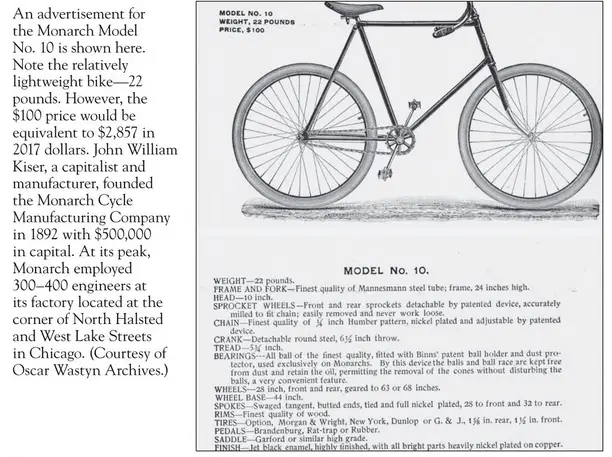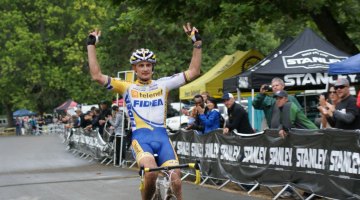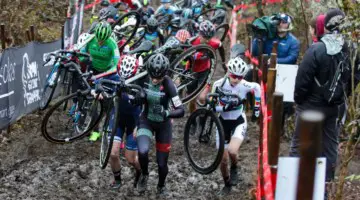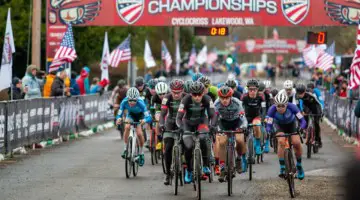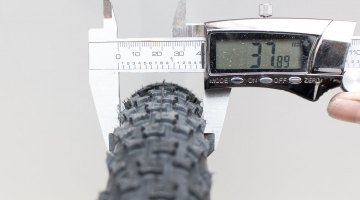In 2016, Bicycling Magazine named Chicago the top biking city in America. With a decades-long commitment to building bike paths and bike lanes, the introduction of the Divvy bike sharing system and of course, the occasional show from Sven Nys, it’s not surprising the Windy City is a good place for cyclists.
Chicago’s recent return to cycling prominence completes a circle that began at the turn of the 20th century. Prior to the introduction of the automobile, Chicago was the Detroit of bicycle manufacturers, with scores of bike companies located within the city’s limits. The story of Chicago’s brief bike dominance is one that has been largely lost to history.
Chicago native Chris McAuliffe caught wind of Chicago’s rich cycling history and decided to write a book about it. The result is “Cycling in Chicago,” which uses a rich collection of photographs to document the many facets of cycling’s history in the Second City.
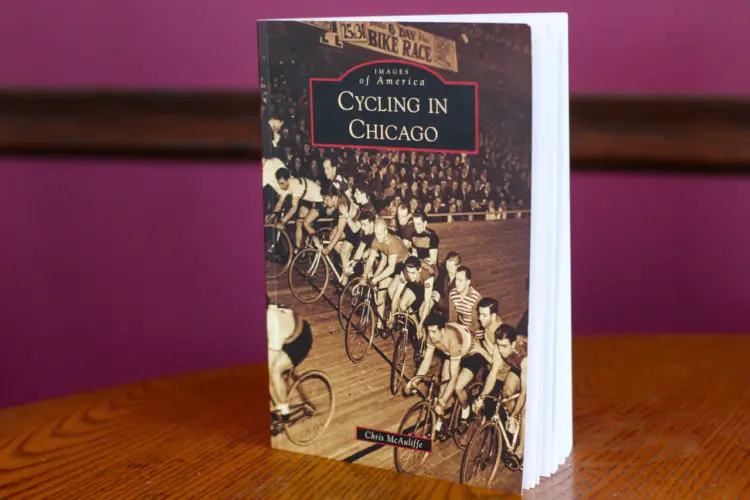
Cycling in Chicago by Chris McAuliffe
“I love cycling and history,” McAuliffe said about the start of the project. “I particularly like history you can see and touch. I had always heard that Chicago had a rich cycling history, particularly with Schwinn Bikes being founded in Chicago. I thought that it would be fun to write a local history book on cycling. Fourteen months after I signed a contract, I was a published author.”
Chicago’s strongest connection to cyclocross has been in recent years with the flourishing of the Chicago Cross Cup and the shows Nys has brought to town during the Sven and Sven clinics the past two seasons. McAuliffe races cyclocross for Chicago’s xXx Racing (the favorite team of Vin Diesel, obviously), and your humble editor grew up in the Chicago suburbs, so I could not say no to a review of McAuliffe’s book.
I will admit, I am not the biggest fan of coffee table-style picture books, but I quickly became engrossed in Cycling in Chicago. McAuliffe tapped into a rich collection of photos from the Oscar Wastyn maintained by the century-old the Wastyn Cycles shop. Black and white photos from the turn of the century document bikes that were built on “Bicycle Row” by the 90 bike manufacturers located in Chicago at that time.
Chicago’s bike industry was hard hit by the introduction of the automobile, as Americans opted for a more passive way of travel. Chicago’s bike boom ended and the activity’s history took a new shape in the new motorized world.
Another section that was very interesting was the one on bike racing in Chicago in the early 20th century. The big events in the first quarter of the 20th Century were six-day track races, where athletes rode around a track for six straight days. Reading about the six-day track races fortuitously helped me find this recent bit of coverage of Major Taylor’s famed cycling career.
McAuliffe said that if there is a follow-up to Cycling in Chicago, it will likely be a book about the ultra ultra … ultra endurance races. “Yes, maybe a book on six-day races,” he said about a potential second project. “In the 1920’s and 30’s, six-day racers were as popular and made as much as some major league baseball players. There are a lot of great stories.”
Cycling in Chicago wraps up with coverage of racing during the mid-century and then Chicago’s investment in bike lanes and paths under the younger Daley and now Emanuel administrations. I personally had a nice flashback looking at photos of the flat bike paths such as the Fox River Trail I used to ride with my parents while growing up, and I imagine other Chicagoans will recognize their local path in all its flat glory. If you are looking for the cyclocross coverage, McAuliffe includes some Chicago Cross Cup photos to nicely wrap up the book.
As mentioned above, I really enjoyed Cycling in Chicago. McAuliffe did a great job digging up photos and wrapping them into chapters that cover the history of cycling in the city. If I had one quibble with the book, it would be for more words! I may be a bit biased as a writer, but I like words. I think the chapter intros could have been a bit longer by incorporating info from the captions into more of a narrative. However, the captions are meaty and do a good job of telling the story alongside the photos, so there’s certainly not a lack of storytelling.
If you are from the Chicago area and like bikes, Cycling in Chicago is probably right up your … lane. The book is also likely to be of interest to anyone who wants to learn about the history of urban cycling in a city that has seen a rebirth as a cycling hotbed thanks to investment in infrastructure and events to promote the activity.
Cycling in Chicago is available from Arcadia Publishing for $14.30 in paperback.
Q and A with Chris McAuliffe About Cycling in Chicago
Since McAuliffe is a member of our cyclocross community, I reached out to him for a brief Q an A about the book to learn more about the project and his personal connection with cycling and Chicago.
Cyclocross Magazine: Where did the idea for this project come from?
Chris McAuliffe: I love cycling and history. I particularly like history you can see and touch. I had always heard that Chicago had a rich cycling history, particularly with Schwinn Bikes being founded in Chicago. I thought that it would be fun to write a local history book on cycling. Fourteen months after I signed a contract, I was a published author.
CXM: Are you originally from Chicago or the region?
CM: Yes, I grew up in the suburbs of Chicago and moved to the city about 20 years ago.
CXM: How are you currently involved in cycling?
CM: I race for xXx Racing-Athletico (Chicago-based team) in cyclocross and on the road. I also do speaking engagements for the book several times a month.
CXM: Favorite Chicago (or region) cycling spot?
CM: Palos Forest Preserve in the southwest suburbs of Chicago. It is 14,000 acres of forest and wetlands located about 23 miles from downtown Chicago. At times, you’d think you are in northern Wisconsin.
CXM: How long did it take to dig up the photos?
CM: The book and all the research took about 14 months.
CXM: It looks like the Wastyn collection played a big help . How many more photos didn’t make the book?
CM: I probably have 200+ photos that didn’t make the book.
CXM: During your research did you get a chance to ride any interesting vintage bikes?
CM: Yes, I rode an original Schwinn Paramount from the late 1930’s. It is part of the Wastyn Family collection. Still in great working condition and very cool.
CXM: What are the coolest and most surprising things you learned about Chicago’s cycling history?
CM: That Chicago was the Detroit of bike manufacturing. Detroit was the center of auto manufacturing and Chicago was the center of bike manufacturing. A century ago, two-thirds of all bikes made in the United States were made in Chicago.
CXM: There are a lot of stories that seem like they are ripe for a more in-depth look. Any plans for a follow-up to Cycling in Chicago?
CM: Yes, maybe a book on Six-Day Races! In the 1920’s and 30’s six-day racers were as popular and made as much as some major league baseball players, A lot of great stories.
CXM: Thanks for your time. Looking forward to seeing you at a Chicago Cross Cup race this fall.
CM: Thank you.















